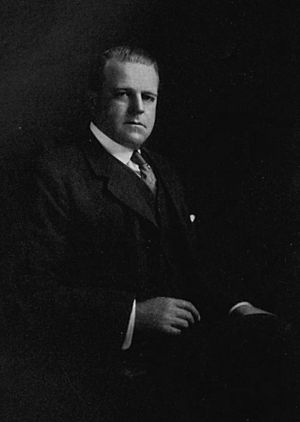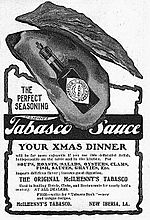Edward Avery McIlhenny facts for kids
Quick facts for kids
Edward Avery McIlhenny
|
|
|---|---|

Edward Avery McIlhenny, portrait from Bird Lore (1916)
|
|
| Born |
Edward Avery McIlhenny
March 29, 1872 |
| Died | August 8, 1949 Avery Island
|
| Nationality | American |
| Occupation | Businessman, explorer, bird bander and conservationist |
Edward Avery McIlhenny (born March 29, 1872, died August 8, 1949) was an American businessman, explorer, and conservationist. He was the son of the person who created Tabasco sauce. Edward McIlhenny was famous for setting up a special place for wildlife on his family's land called Avery Island in Louisiana. He also helped protect a huge area of coastal marshland in Louisiana as a safe home for birds. He even brought in some interesting plants from other parts of the world to his private garden, Jungle Gardens.
Some people say McIlhenny is responsible for bringing nutria (a type of large rodent) to Louisiana, where they have become a big problem for the environment. While he wasn't the very first to bring them there or let them go, he strongly supported bringing them in. This made him well-known for their arrival in the state.
Contents
Edward McIlhenny's Life Story
Edward McIlhenny was born in 1872 on Avery Island, Louisiana. His family had lived there since 1818. He went to private schools and military academies. In 1892, he started college at Lehigh University.
However, he left college to join an Arctic expedition in 1894. He went as a bird expert, also called an ornithologist. This trip ended when their ship crashed near Greenland. In 1897, he went on another Arctic trip to Point Barrow, Alaska. During this trip, he helped a group of whaling sailors who were stranded. He gave them shelter and hunted animals to feed them.
After his second Arctic trip, he married Mary Givens Matthews on June 6, 1900.
Running the Tabasco Business

In 1898, Edward's older brother joined the military. So, Edward took over the family business. This company made Tabasco sauce, a famous hot pepper seasoning. His father had invented it about 30 years before.
Edward changed the company's name to McIlhenny Company. He worked to make more sauce and improve how it was made. He also tried new ways to advertise the sauce, like using radio.
In 1927, McIlhenny changed the Tabasco bottles. For almost 60 years, they had cork tops. He replaced them with the screw-top bottles we see today. He also redesigned the well-known Tabasco diamond logo.
Nutria Farming and Release
Edward McIlhenny also had a nutria farm on Avery Island. He started it in 1938 and ran it until he died. Nutria are large rodents that look a bit like beavers.
He got his first nutria in 1938. His nutria farm grew very quickly. He was surprised by how fast they had babies and how hard it was to keep them in their pens. On June 1, 1940, he let about 20 nutria go free. In 1945, he released all of his nutria. He said he hoped it would help create a fur industry in Louisiana. However, the nutria became a big problem for the environment in Louisiana.
Working to Protect Nature
After his first Arctic trip, Edward McIlhenny noticed that there were far fewer egrets (a type of bird) on Avery Island. This made him want to try raising them in captivity.
Around 1895, McIlhenny started a wildfowl refuge called Bird City on Avery Island. This helped save the snowy egret from disappearing forever.
In 1910, McIlhenny and Charles Willis Ward bought a large area of marshland. They later bought even more land. On November 4, 1911, they gave this marshland to the state of Louisiana as a wildlife refuge. McIlhenny also convinced other groups to buy more land for birds. This created a huge bird reserve of about 174,663 acres.
McIlhenny loved studying the birds on his land. In 1912, he started bird banding. This is where a small band is placed on a bird's leg to track it. He used his own bands at first, but later used official ones. Between 1912 and 1942, he banded 286,743 birds! His studies helped scientists learn how black vultures move around.
In 1941, he wrote about the possible disappearance of the ivory-billed woodpecker. He noted that it used to live on Avery Island. He thought that cutting down old forests was causing its decline. A type of white-tailed deer on Avery Island was even named after him.
McIlhenny used his 170-acre private land, called Jungle Gardens, to grow many different plants. These included plants native to Louisiana and others he brought from other places. Some of these plants were azaleas, irises, camellias, and bamboo.

He wrote many articles about birds and reptiles. He also wrote books, including:
- Befo' De War Spirituals: Words and Melodies (1933)
- Bird City (1934)
- The Alligator's Life History (1935)
- The Autobiography of an Egret (1940)
His Death and What He Left Behind
Edward McIlhenny passed away in 1949. He is buried on Avery Island.
Today, Jungle Gardens and Bird City are still safe places for birds and plants. They are also popular places for tourists to visit. The nearly 175,000 acres of coastal marshland he helped protect are still state wildlife areas. McIlhenny's drawings and writings about plants and animals on Avery Island are now part of a special collection at Louisiana State University.
See also
- John Avery McIlhenny
- Walter S. McIlhenny

